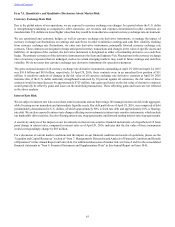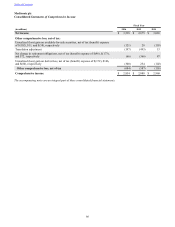Medtronic 2016 Annual Report Download - page 73
Download and view the complete annual report
Please find page 73 of the 2016 Medtronic annual report below. You can navigate through the pages in the report by either clicking on the pages listed below, or by using the keyword search tool below to find specific information within the annual report.
Table of Contents
Medtronic plc
Notes to Consolidated Financial Statements (Continued)
70
1. Summary of Significant Accounting Policies
Nature of Operations Medtronic plc (Medtronic or the Company) is the global leader in medical technology – alleviating pain,
restoring health, and extending life for millions of people around the world. The Company provides innovative products and
therapies to serve hospitals, physicians, clinicians, and patients. Medtronic was founded in 1949 and is headquartered in Dublin,
Ireland. Medtronic plc is the successor registrant to Medtronic, Inc.
Principles of Consolidation The consolidated financial statements include the accounts of Medtronic plc and its consolidated
subsidiaries. All significant intercompany transactions and accounts have been eliminated.
Use of Estimates The preparation of the consolidated financial statements in conformity with generally accepted accounting
principles in the United States (U.S. GAAP) requires management to make estimates and assumptions that affect the reported
amount of assets and liabilities, contingencies, and revenues and expenses in the consolidated financial statements and
accompanying notes, sales discounts, rebates, allowances and incentives, warranty obligations, income tax reserves, depreciation,
amortization, employee benefits, contingencies, and intangible asset and liability valuations. Actual results may or may not differ
from those estimates.
Fiscal Year-End The Company utilizes a 52/53-week fiscal year, ending the last Friday in April. The Company’s fiscal years
2016, 2015, and 2014 ended on April 29, 2016, April 24, 2015, and April 25, 2014, respectively. Fiscal year 2016 was a 53-week
year, with the additional week occurring in the first quarter. Fiscal years 2015 and 2014 were 52-week years.
Cash Equivalents The Company considers highly liquid investments with maturities of three months or less from the date of
purchase to be cash equivalents. These investments are carried at cost, which approximates fair value.
Investments Investments in marketable equity securities and certain debt securities are classified and accounted for as available-
for-sale. Debt securities include corporate debt securities, government and agency securities, certificates of deposit, mortgage-
backed securities, other asset-backed securities, debt funds, and auction rate securities. These investments are recorded at fair value
in the consolidated balance sheets. The change in fair value for available-for-sale securities is recorded, net of taxes, as a component
of accumulated other comprehensive (loss) income on the consolidated balance sheets. Management determines the appropriate
classification of its investments in debt and equity securities at the time of purchase and reevaluates such determinations at each
balance sheet date. The classification of marketable securities as current or long-term is based on the nature of the securities and
their availability for use in current operations consistent with how the Company manages its capital structure and liquidity.
Investments in securities that are classified and accounted for as trading securities primarily include exchange-traded funds and
are recorded at fair value on the consolidated balance sheets. The Company seeks to offset changes in liabilities related to equity
and other market risks of certain deferred compensation arrangements. The change in fair value for trading securities is recorded
as a component of interest expense, net on the consolidated statements of income.
Certain of the Company’s investments in equity and other securities are long-term, strategic investments in companies that are in
varied stages of development. These investments are included in other assets on the consolidated balance sheets. The Company
accounts for these investments under the cost or the equity method of accounting, as appropriate. Certain of these investments are
publicly traded companies and are therefore accounted for as available for sale. The valuation of equity and other securities
accounted for under the cost method considers all available financial information related to the investee, including valuations based
on recent third-party equity investments in the investee. If an unrealized loss for any investment is considered to be other-than-
temporary, the loss is recognized in the consolidated statements of income in the period the determination is made. Equity securities
accounted for under the equity method are initially recorded at the amount of the Company’s investment and are adjusted each
period for the Company’s share of the investee’s income or loss and dividends paid. Equity securities accounted for under both
the cost and equity methods are reviewed quarterly for changes in circumstance or the occurrence of events that suggest the
Company’s investment may not be recoverable. See Note 5 for discussion of the gains and losses recognized on equity and other
securities.
Inventories Inventories are stated at the lower of cost or market, with cost determined on a first-in, first-out basis. The Company
reduces the carrying value of inventories for those items that are potentially excess, obsolete or slow-moving based on changes in
customer demand, technology developments or other economic factors. Inventory balances are as follows:
























